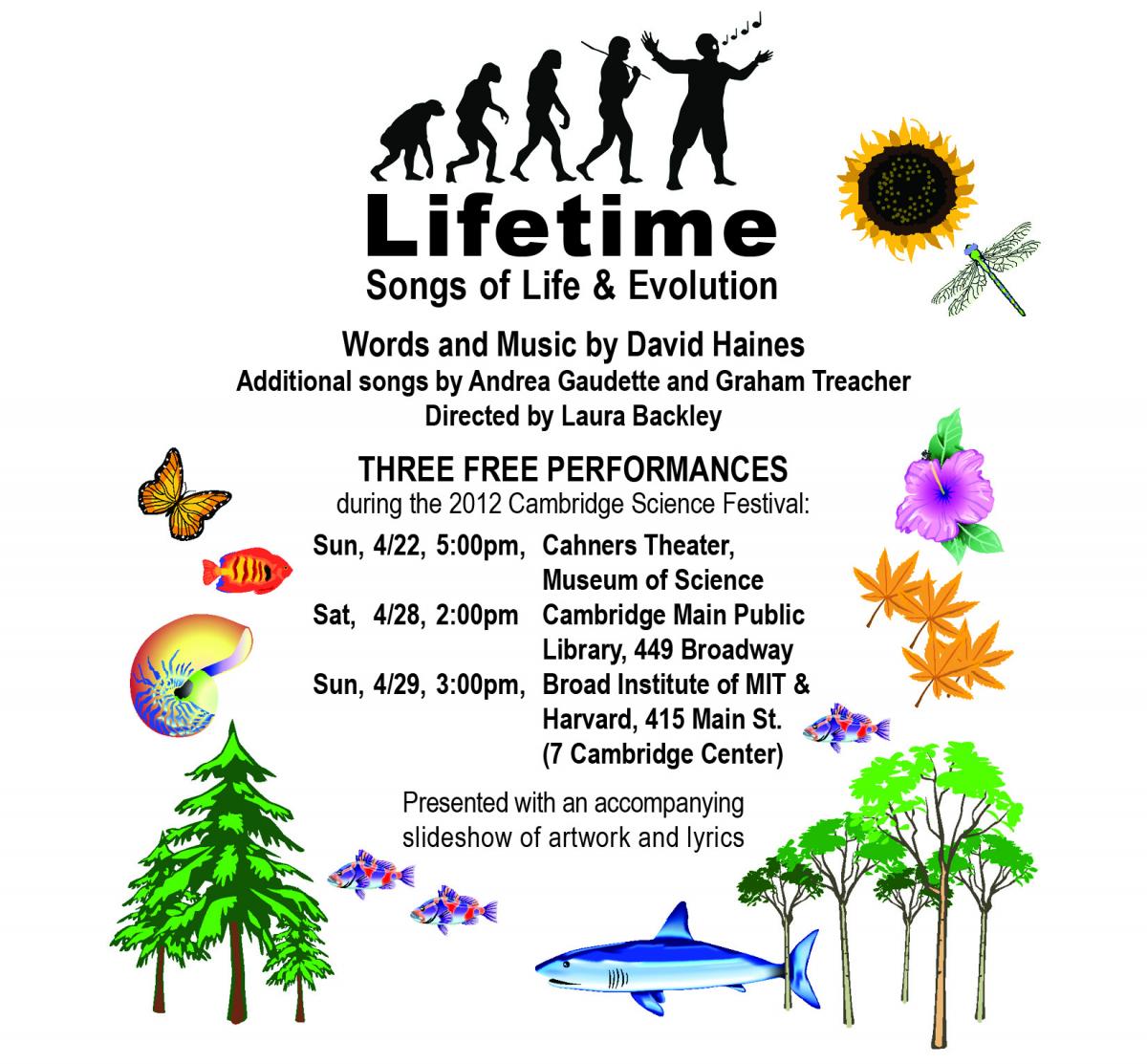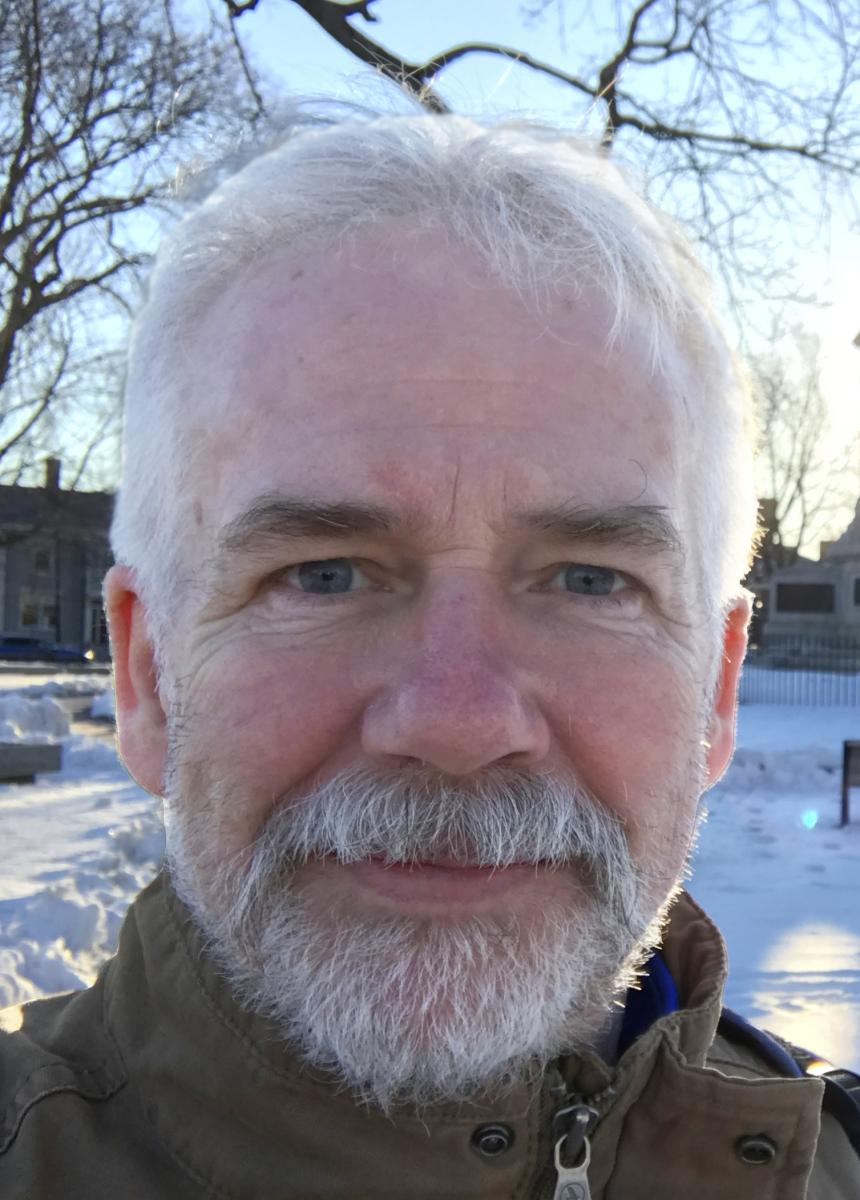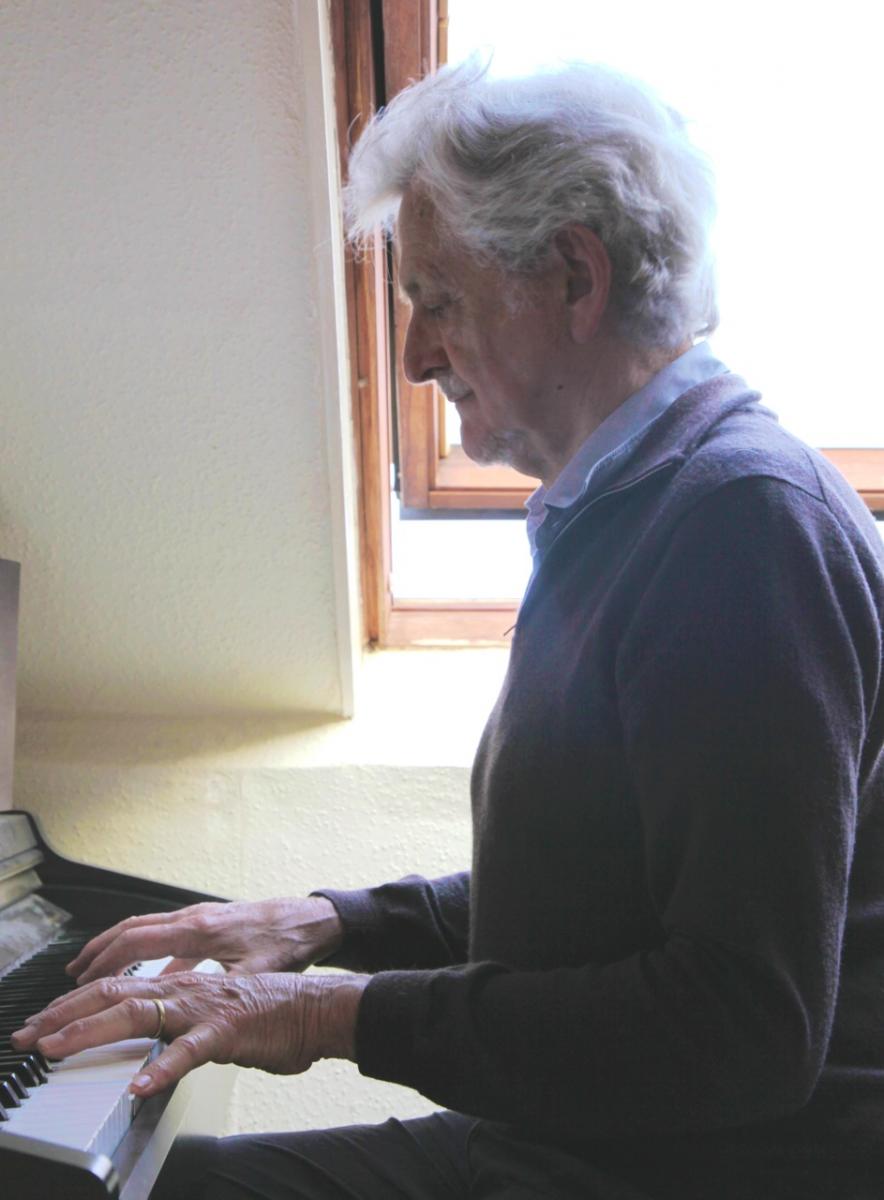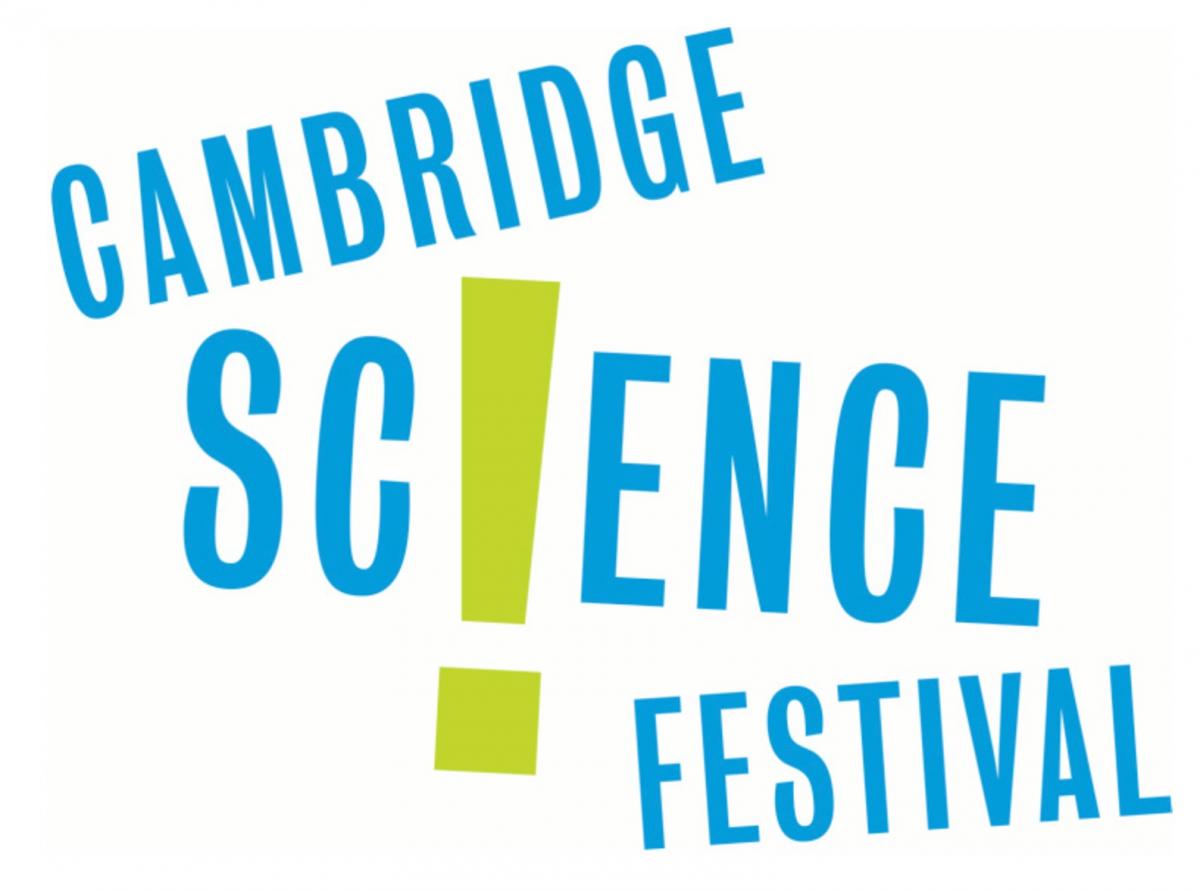2012 Lifetime

Lifetime: Songs of Life and Evolution is a collection of 22 entertaining and inspiring songs about biology and the origins of life, conceived of and composed by David Haines, with additional songs by Andrea Gaudette and Graham Treacher. Lifetime was performed by the NCFO Science Festival Chorus as part of the sixth annual Cambridge Science Festival, April 20-29, 2017. The performances also included a medley of songs composed by Cambridge Public School students under the direction of David Haines, as part of David's CPS Songwriting Workshops. The St. Peter School Singing Club joined the NCFO Science Festival Chorus for four of the songs.
You may peruse/download the program booklet from Lifetime HERE.
See below for recordings of the music from Lifetime and information about the composers and lyricists who wrote it.
David Haines, piano
Armond Cohen, drums
Slide show by Carla Procaskey
Photos by Mark Jaquith
 |
Trained at Bristol University, London's Guildhall School, and Banff School of Fine Arts, |
Lifetime features 17 songs by David Haines, plus a collection of songs written by David in collaboration with young children during his songwriting workshops in the Cambridge Public Schools:
- Amoeba: Even the apparently most primitive of life forms can show an amazing degree of complexity in their structures and behaviors.
[ performance audio / performance with slide show / demo ]
- Axolotl: The axolotl is a creature as strange as its name. It lives in a single Mexican Lake and is an amphibian that never grows up, living its life, reproducing and dying entirely in its larval state, a phenomenon known as neoteny. Its amazing ability to re-grow limbs which have been severed is of especial interest to scientists who hope to stimulate the same ability in humans following injury.
[ performance audio / performance with slide show / demo ]
- Birth: The origins of Life on Earth will probably always be shrouded in mystery, since they can have left no direct record. But the fossil record of life goes way back to Earth’s infancy. Did life begin on this young planet with the gradually increasing complexity of self-replicating molecules? Or did it start elsewhere in the universe, to be delivered here aboard rocks blasted from other planets such as Mars?
[ performance audio / performance with slide show ]
- Cetaceans: We humans have so much in common with the aquatic mammals (hairlessness, blubber, complex communication, etc.) that a minority of scientists suggest we may have gone through a semi-aquatic phase during our evolution. Maybe this helps to explain the strange fascination that the dolphins, porpoises and whales hold for us.
[ 2007 performance audio / 2013 performance with slide show / demo ]
- Eras: The history of Life on Earth is so vast in comparison to a human life span that it’s impossible to comprehend fully. But at least giving names to these great tranches of time gives us some sort ofhandle on Life’s history.
[ performance audio / performance with slide show ]
- Extremophiles – Archaebacteria, the oldest kingdom of life, contain no discrete intracellular organelles, such as nuclei or mitochondria. They withstand extremes of temperature, pH, salinity, pressure and lack of oxygen that most other life cannot.
[ performance audio / performance with slide show ]
- Hedgehog – While some life forms migrate to escape inhospitable seasons, others retreat into hibernation.
[ performance audio / performance with slide show ]
- Four Billion Years – Despite the words of this song, it’s unlikely that Homo Sapiens could destroy all life on earth, even in the event of nuclear holocaust. But we are the main cause of a catastrophic mass extinction that is happening all around us right now. It would be tragic if the one species on Earth capable of appreciating the enormous diversity of life turned out to be the cause of its impoverishment.
[ performance audio / performance with slide show / demo ]
- Lake: New species generally arise when populations of a single species become separated. In adapting to their environments over long periods of time, the populations become genetically distinct to the point where interbreeding is no longer possible even if the populations are reunited. A beautifully clear and simple example of this process is the rise and fall of water levels in the great African lakes. At low water levels the various populations of cichlid fish have diverged genetically in the separate, smaller lakes thus formed. When the water level rises these new, separate species are again free to intermingle in the single larger lake but can no longer interbreed. Thus Lake Malawi alone contains some 200 species of cichlid, all tracing their ancestry back to a single species in the distant past.
[ performance audio / performance with slide show / demo ]
- Life That Lives on Man: Partly spoken, partly sung, this describes just three of the numerous lifeforms inhabiting the human skin and hair. Narrated by Claire Hesley, Erica Jaquith, John Kernochan and Kailash Nakagawa.
[ performance audio / performance with slide show / demo ]
- Living Light: It’s hard to think of an evolutionary niche that life hasn’t adapted to. Name an evolutionary strategy, and it’s usually been followed many times on separate occasions by life forms from different kingdoms or phyla. The evolution of bio-luminescence is one such example.
[ performance audio / performance with slide show / demo ]
- Mister Darwin: We all remember Charles Darwin as the genius who realized that the evolution of species was driven by the engine of natural selection. But a land-owner and fruit farmer named Patrick Matthew came up with the idea nearly 30 years earlier in a book boringly titled Shipbuilding and Arboriculture. Matthew did not recognize the importance of his suggestions however, and nobody took any notice. Darwin, fearing the controversy that he accurately predicted would follow the publication of this theory, dithered for twenty years after returning from his voyage on The Beagle. Only when the younger naturalist, Alfred Russell Wallace, sent him his own version of the theory, independently arrived at from his own observations and travels, did Darwin race to get his Origin of Species into print. Solos by Erica Jaquith, Robbie Kelley, Emma Adler, Glenn McElhoe and Kailash Nakagawa
[ performance audio / performance with slide show / demo ]
- Mutate!: DNA copies itself to pass on characteristics to the next generation, but sometimes mistakes arise. We tend to think of these mutations in negative terms, and usually they do result in less viable organisms (not super-heroes or super-villains). But without mutations, evolution just couldn’t happen. It’s those random variations in genetic inheritance that enable natural selection to do its work.
[ performance audio / performance with slide show / demo ]
- Queen Bee: The hedgehog only has to look after itself in the spring and perhaps find a mate to start a family. But the Queen bumble bee, having spent the winter in hibernation alone, has to found a whole colony whose complex social organization will thrive for one season then die off again when the cold weather arrives. Performed with the St. Peter's School Singing Club.
[ performance audio / performance with slide show ]
- Reptiles: The Animal Kingdom threw up its most exuberant collection of life forms to date when the Reptiles came to the fore. They dominated non-marine life on Earth for a vast expanse of time, yet almost entirely vanished in a flash, geologically speaking. The most likely explanation is that a huge asteroid landed in the Yucatan Peninsula, Mexico and that the subsequent dust thrown into the atmosphere led to an abrupt change in global climate that wiped out nearly all life forms on Earth.
[ performance audio / performance with slide show ]
- Taxonomy – Estimates of the number of species of life living on Earth rise higher every year, currently standing at around 30 million. We need a system to organize our knowledge of this constantly shifting mass of information, and taxonomic classification provides that system. We humans have our own place in the family tree. As the song says: Kingdom – Animal, Phylum – Chordate, Class – Mammal, Order – Primate, Family – Hominid, Genus – Homo; Homo Sapiens, that’s the species of every human that you know.
[ performance audio / performance with slide show ]
- Virus: Life could not exist without DNA, but DNA by itself is not life. Surrounding DNA with a few protein molecules can create a virus, but is that enough to create life? Scientists debate whether a virus can be called “life”, but there is no disagreement about how miserable a cold virus can make you feel.
[ performance audio / performance with slide show / demo ]
- Songs written with young school children (world premiere) – Every year David Haines works with about 50 classrooms in the Cambridge schools, guiding the students as they write a song about some aspect of their science curriculum. These are some songs that touch on biology and the origins of life:
• Insects - Graham and Parks, 1st/2nd grade
• Rainforest - Amigos, 1st grade
• Mealworms - King, 2nd grade
• Animal, Number, Legs - Peabody, Junior Kindergarten
• Sad Dinosaur Song - Haggerty, Kindergarten
• Volcano Island - Graham and Parks, 1st/2nd grade
• Mothers and Babies - Tobin Montessori, ages 3-6
• Taste - King, 1st grade
• Making Maple Syrup - Haggerty, 1st grade
[ performance audio / performance with slide show ]
 |
Andrea Gaudette has been playing music professionally since |
Lifetime features three songs by Andrea Gaudette:
- Metamorphosis (world premiere) – The life story of the ladybug. Performed with the St. Peter's School Singing Club.
[ performance audio / performance with slide show ]
- Mitosis (world premiere) – The cycle of cell division is broken into six phases. Errors during the process of mitosis create the mutations that facilitate evolution.
[ performance audio / performance with slide show ]
- Winter (world premiere) – Not all arctic and temperate species can survive the cold weather, but all have evolved ways for their DNA to do so.
[ performance audio / performance with slide show ]
 |
Graham Treacher is a composer and conductor living in London. |
Web of Life features two songs by Graham Treacher:
- Song of DNA – All the information that defines a living thing is contained within its DNA, the miraculous double-helix molecule. The order of nucleotides, the building blocks of DNA, defines the genes which determine all the physical characteristics of living things. The chorus performs a musical double-helix at the end of the song. Performed with the St. Peter's School Singing Club.
[ performance audio / performance with slide show / demo ]
- The Song of the Octopus – Octopus and squid eyes look remarkably like our own, but they evolved completely differently. Our eyes grew from brain tissue, while cephalopod eyes developed from light-sensitive patches on the skin, a classic example of convergent evolution. Performed with the St. Peter's School Singing Club.
[ performance audio / performance with slide show / demo ]
»






